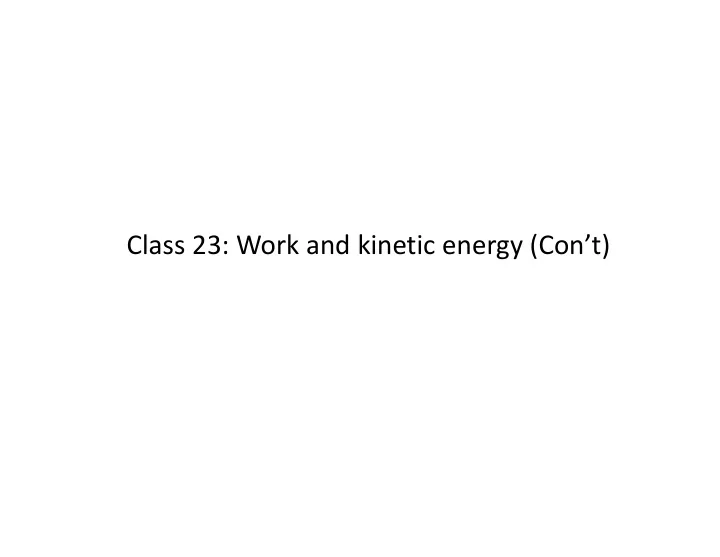

Class 23: Work and kinetic energy (Con’t)
Acceleration by chain rule (1D) If we know the velocity as a function of time, we can differentiate it w.r.t. time and find out how the acceleration depends on time: dv x a dt However, very often we only know the velocity as a function of position (i.e. coordinate x). What to do in this case? dv dx dv a x dt dt dx dv a v x dx
The answer In most cases we live in a “force field” – there is always a force acting on us and this force depends on where we are. x 2 d d F m x F m v x x x 2 dt dx d m v v F x x x dx x 1 1 f 2 2 mv - mv F dx xf xi x 2 2 x i
3D x 1 1 f 2 2 mv - mv F dx fx ix x 2 2 x i y 1 1 f 2 2 mv - mv F dy fy iy y 2 2 y i z 1 1 f 2 2 mv - mv F dz fz iz z 2 2 + z i x y z 1 1 f f f 2 2 mv - mv F dx F dy F dz f i x y z 2 2 x y z i i i
Work (abbreviation: W) x y z f f f Work done W by a force F F dx F dy F dz x y z x y z i i i 1. Work is a scalar (sum of definite integrals) – it has no direction. 2. Unit of work: Joule (J). Joule is not a fundamental unit, J Nm Kgm 2 s ‐ 2 . 3. Work done by a force can be positive, negative, or 0.
Dot product (a.k.a. scalar product) y A B A B A B A B x x y y z z B A x A B | A || B | cos 1. The result is a scalar, that’s why its called the scalar product. 2. The equivalency is useful to calculate the angle between two vectors, if you know the components of these two vectors.
Work x y z f f f Work done W by a force F F dx F dy F dz x y z x y z i i i x y z f f f F F dx F dy F dz x y z x y z i i i x y z f f f F dr F dr F dr x x y y z z y x y z i i i r f Work done W by a force F F d r r f F r i dr x dr r i F
When F is constant x y z f f f Work done W by force F F dx F dy F dz x y z x y z i i i x y z f f f F dx F dy F dz x y z x y z i i i F x F y F z x y z ˆ ˆ ˆ F d ( d x i y j z k r r ) y f i F F Path independent r f x d r i
More than one force x 1 1 f 2 2 mv - mv F dx fx ix x 2 2 x i y 1 1 f 2 2 mv - mv F dy fy iy y 2 2 y i z 1 1 f 2 2 mv - mv F dz fz iz z 2 2 + z i x y z 1 1 f f f 2 2 mv - mv F dx F dy F dz f i x y z 2 2 x y z i i i Dot product notations x 1 1 f 2 2 mv - mv F d r One force: f i 2 2 x i x x 1 1 f f 2 2 mv - mv F d r F d r f i i i Many forces: 2 2 i i x x i i Total work Work done by total force
Kinetic energy (abbreviation: K) 1 1 1 2 2 2 2 m(v v v ) mv m v v Kinetic energy of a moving particle x y z 2 2 2 1. Kinetic energy is a scalar – it has no direction. 2. Unit of kinetic energy: Joule (J), the same unit as work. 3. Kinetic energy is always positive, because m>0 and v 2 >0. There is no negative kinetic energy.
Recommend
More recommend